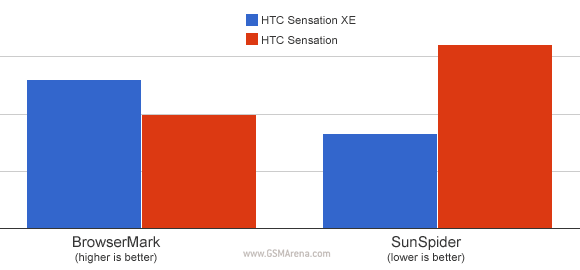HTC Sensation XE
Out of one party and into the other - HTC is showing off yet more hot gadgetry and we’re going hands-on with it. After yesterday’s Rhyme launch, today we’ll be playing with an even hotter piece of smartphone technology. The Sensation XE is not only the new HTC flagship, but its also the company's first dip into the audiophile pool.



HTC Sensation XE official photos
The Sensation XE was officially announced a week ago and now we get a chance to play with it for the first time. Needless to say that we were pretty excited as it represents quite an improvement even over the already impressively specced Sensation. We are talking an even faster dual-core CPU (1.5GHz vs. 1.2GHz), an updated Sense UI (v3.5) and the addition of the highly regarded Beats audio to the mix here.
For starters, here's a quick overview of the HTC Sensation XE key specs:
HTC Sensation XE at a glance:
- General: GSM/GPRS/EDGE 850/900/1800/1900 MHz, UMTS 900/2100 MHz, HSDPA 14.4 Mbps, HSUPA 5.76 Mbps
- Form factor: Touchscreen bar phone
- Dimensions: 126.1 x 65.4 x 11.3 mm, 151 g
- Display: 4.3" 16M-color qHD (540 x 960 pixels) S-LCD capacitive touchscreen; Gorilla glass
- Platform: Dual-core 1.5 GHz Scorpion processor, Adreno 220 GPU, Qualcomm MSM 8260 Snapdragon chipset
- RAM: 768MB
- OS: Android 2.3.4 (Gingerbread)
- Memory: 1 GB storage, microSD card slot (16GB in the box)
- Camera: 8 megapixel auto-focus camera with face detection, touch focus and image stabilization; Full HD (1080p) video recording at 30fps, dual LED flash, VGA front facing camera
- Connectivity: Wi-Fi a/b/g/n, Wi-Fi hotspot, Bluetooth 3.0+HS, standard microUSB port, GPS receiver with A-GPS, 3.5mm audio jack, FM radio, TV-out (MHL)
- Misc: Sense 3.5 UI, DivX/XviD codec support, Beats audio enhancements and headphones in the package, 1730mAh battery, built-in accelerometer, multi-touch input, proximity sensor, gyroscope sensor, ultra-fast boot times
Beats Audio is the result of HTC and Beats by Dr. Dre teaming up and will come in the form of special sound processing on the inside and a special Beats headset in the box.



HTC Sensation XE
The headset will be called YourBeats and they are a variation of iBeats (iBeats, YourBeats… yeah). They sport a full set of controls for the media player and the Beats functionality becomes active only when using the headset (sorry, loudspeaker).
And when we say the headset, we mean the headset - regular headsets will get some improvement over, say, using them on a non-Beats phone, but not as much as the YourBeats headset gets.
Once you plug in a YourBeats headset, a special icon pops up in the notification area with a button to disable Beats.

Beats has its reserved spot in the notification area
The Sensation XE being a music-oriented phone comes with a 16GB microSD card right out of the box - plenty of room for a respectable music collection.
Benchmarks
This may be a quick hands-on but we still found enough time to run a few benchmarks. We were unable to install any benchmarking apps so we ran browser-based benchmarks instead.
We ran BrowserMark and the Sensation XE bested the old Sensation easily - 52019 vs. 39673 (higher is better). In SunSpider, XE blew the old model out of the water, passing the test in about half the time - 3336.2ms vs. 6428ms (lower is better).

Since the 300MHz speed bump can’t account for such an increase in performance, it’s safe to say that HTC has been busy at work optimizing JavaScript performance. Either way, with the Sensation XE you could count on some of the smoothest web browsing in Android-land.
We also tried out the browser's Flash performance - 720p YouTube videos ran smoothly, but the browser crashed when we tried a 1080p one.
First impressions
It took HTC five months and a $300 million acquisition to go from Sensation to Sensation XE, but it seems to have been worth it. The CPU frequency boost makes sure the performance keeps up with the competition, while the Beats audio tweaks add an extra bit of sexy to the already successful mix.
The improvement in audio quality and the high-quality headset will be more than enough to generate sales of their own. Not that the headphones that came with the original Sensation and its audio output were bad, but what we have with the Sensation XE is certainly among the best audio experiences so far.
The serious intent of the Sensation XE to beat your dedicated PMP at its own game is confirmed by the even larger battery that has been fitted inside it. What’s more impressive is that HTC managed to squeeze 210 mAh of power in a body that hasn’t grown a millimeter in any direction.
Speaking of the body, we have to say that we are pretty fond of the facelift that the Sensation XE received. The bold red accents seem to work really well on the metallic body, so you are getting a much more youthful, but still really hot looking device at the end.
So to sum it up, if you've recently bought a Sensation, then making the switch to Sensation XE may not be worth it, but if you're on a lookout for a new high-end droid, the special headset and extra performance make the XE a strong contender.


No comments:
Post a Comment